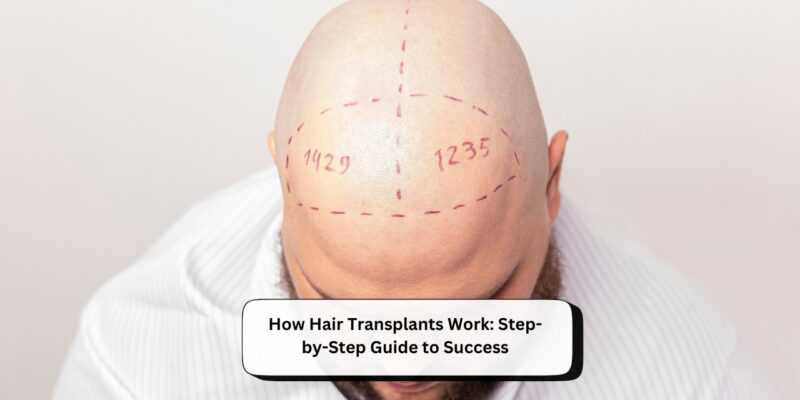How Hair Transplants Work: Step-by-Step Guide to Success
Hair loss is a challenge that many people face, whether due to genetics, stress, or other factors. However, hair transplants have become a popular and effective solution for those seeking to restore their hair and regain confidence. If you’ve ever wondered, “How hair transplants work?” or “What is the process behind it?”, you’ve come to the right place.
In this step-by-step guide to success, we’ll take you through the hair transplant process, explain how it works, and share why it’s one of the most reliable solutions for hair restoration. Plus, we’ll highlight successful hair transplant results that could inspire you to take the next step toward your hair restoration journey.
How Hair Transplants Work: Step-by-Step Guide to Success
What is a Hair Transplant?
Before diving into the hair transplant procedure, let’s start with the basics. A hair transplant is a surgical technique in which hair follicles are removed from one part of your body (usually the back or sides of the scalp, where hair growth is most abundant) and transplanted to areas where hair is thinning or missing.
This technique helps people experiencing various types of hair loss, including male pattern baldness, female pattern baldness, or hair loss due to injuries or scars.
For more details, you can refer to the Wikipedia page on hair transplants.
Step 1: Initial Consultation with Experts
The first step in any hair transplant process is an initial consultation with a hair transplant specialist. During this meeting, the surgeon will evaluate your hair loss, discuss your goals, and determine whether you are a good candidate for the procedure. This consultation is essential because it helps set realistic expectations and tailor the procedure to your specific needs.
At iGraft, consultations are comprehensive and personalized to ensure that each patient receives the best possible care and advice. We discuss your medical history, examine your scalp, and provide you with all the information you need to make an informed decision about the hair transplant procedure.
Step 2: Preparation for the Procedure
Once the consultation is complete and you decide to move forward, the next step is preparation. On the day of the procedure, your scalp will be cleaned and numbed using a local anesthetic to ensure you feel no pain during the surgery.
Your surgeon will mark the areas on your scalp where the hair follicles will be harvested and transplanted. At this point, you will be guided through the entire process, which helps you feel relaxed and confident. It’s a key part of ensuring successful hair transplant results!
Step 3: Harvesting the Hair Follicles
This is where the magic happens. There are two primary methods used to harvest the hair follicles:
Follicular Unit Transplantation (FUT)
In this method, a strip of skin from the donor area (usually the back of the head) is removed, and the hair follicles are carefully dissected from the strip. This technique allows the surgeon to harvest a large number of hair follicles in one go.
Follicular Unit Extraction (FUE)
In FUE, individual hair follicles are removed directly from the donor area using a small punch device. This method is less invasive than FUT and leaves no linear scar. FUE is ideal for people who prefer shorter hairstyles as it results in minimal scarring.
Both methods have their pros and cons, and your surgeon will choose the best technique based on your scalp condition, hair loss pattern, and preferences.
At iGraft, we specialize in both FUT and FUE methods, tailoring the procedure to each patient’s needs. Visit iGraft’s hair transplant services to learn more about our approach.
Step 4: Transplanting the Hair Follicles
After harvesting the hair follicles, the next step is to implant them into the thinning or bald areas of your scalp. The surgeon will create tiny incisions in the recipient area and carefully place each follicle into the scalp, ensuring that they follow the natural growth pattern of your hair.
This is a meticulous process that requires great precision to ensure natural-looking results. The orientation, depth, and density of the follicle placement all contribute to the overall success of the transplant.
Step 5: Post-Surgery Care and Recovery
The recovery period after a hair transplant procedure varies from person to person. After the surgery, you will likely experience some swelling, redness, or scabbing in the donor and recipient areas. This is completely normal and will subside within a few days to a week.
Your surgeon will provide you with detailed instructions on post-transplant care. It’s important to follow these instructions carefully to avoid infection and ensure the best possible outcome. You may be asked to avoid vigorous activities or touching your scalp for a few days after the procedure.
One of the most crucial aspects of a successful transplant is proper aftercare. At iGraft, we offer post-operative support and ensure you are comfortable throughout the recovery process. You can learn more about our aftercare services by visiting iGraft’s post-transplant care guide.
Step 6: The Wait – When Will You See Results?
Hair transplants do not yield instant results. After the procedure, the transplanted hair follicles will enter a resting phase and begin shedding within the first 2-3 weeks. Don’t worry – this is part of the process! New hair will begin to grow in the transplanted areas after 3-4 months, with noticeable results appearing after 6-9 months.
Most patients see full results within 12 months after the procedure. That’s when the hair transplant process truly begins to show its success, and you’ll be able to enjoy the natural-looking, permanent results that you’ve been waiting for.
Step 7: Long-Term Care and Maintenance
After the first year, you’ll need to maintain a healthy scalp and hair to ensure the longevity of the results. Continue to follow your surgeon’s advice on hair care and general health. Regular check-ups are also recommended to monitor the progress and address any concerns.
Many patients opt for follow-up treatments or minor touch-ups to achieve even better results. At iGraft, we guide our patients through every stage of their hair restoration journey to ensure that they maintain healthy, thick hair for years to come.
Why Choose Hair Transplantation?
Hair transplants offer a permanent, natural solution to hair loss, making them a popular choice among those who have exhausted other methods. Unlike topical treatments or medications, hair transplants provide long-lasting, reliable results with minimal maintenance.
If you’re tired of seeing thinning hair and want to restore a fuller, healthier head of hair, a hair transplant might be the perfect solution for you.
To learn more about how hair transplants work and whether it’s right for you, visit iGraft’s hair transplant consultation page.
Conclusion: The Journey to a Fuller Head of Hair
A hair transplant is a step-by-step process that can transform your life, restoring not only your hair but your confidence as well. Whether you’re opting for FUE, FUT, or any other method, understanding how hair transplants work is key to making an informed decision.
Remember, successful hair transplant results come with careful planning, expert surgeons, and proper aftercare. At iGraft, we’re here to guide you every step of the way. Ready to take the first step? Visit iGraft’s official site to book your consultation today!










